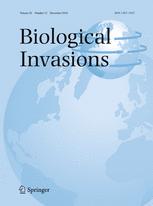Ver ítem
- xmlui.general.dspace_homeCentros Regionales y EEAsCentro Regional Patagonia NorteEEA BarilocheArtículos científicosxmlui.ArtifactBrowser.ItemViewer.trail
- Inicio
- Centros Regionales y EEAs
- Centro Regional Patagonia Norte
- EEA Bariloche
- Artículos científicos
- Ver ítem
A first worldwide multispecies survey of invasive Mediterranean pine bark beetles (Coleoptera: Curculionidae, Scolytinae)
Resumen
Several European and Mediterranean species of pine bark beetles (Coleoptera: Curculionidae: Scolytinae) have become established in North America and the southern hemisphere, posing a novel threat to planted and naturally-occurring pine forests. Our objectives were to investigate (1) the occurrence and relative abundance of pine bark beetles in these regions, and (2) the trapping performance of different blends of multispecies lures. In 2016–2017 a network
[ver mas...]
Several European and Mediterranean species of pine bark beetles (Coleoptera: Curculionidae: Scolytinae) have become established in North America and the southern hemisphere, posing a novel threat to planted and naturally-occurring pine forests. Our objectives were to investigate (1) the occurrence and relative abundance of pine bark beetles in these regions, and (2) the trapping performance of different blends of multispecies lures. In 2016–2017 a network of interception traps was installed in six non-European countries (Argentina, Australia, New Zealand, South Africa, the United States, and Uruguay), and in six European countries (France, Greece, Hungary, Italy, Portugal, and Spain) for comparison. Half of the traps were baited with alpha-pinene and ethanol, and the other half with alpha-pinene, ethanol, and a combination of bark beetle pheromones (ipsdienol, ipsenol, and Z-verbenol). Five Mediterranean scolytine species (Hylurgus ligniperda, Hylastes ater, H. angustatus, Orthotomicus erosus, and O. laricis) were found in non-European countries. Hylurgus ligniperda and Hylastes ater were the most widespread species found in several of the invaded regions, while O. laricis and
H. angustatus occurred only in Argentina and South Africa, respectively. Despite large variation among species and countries, most species were trapped with the blend containing bark beetle pheromones, except O. erosus, which was more attracted to alpha-pinene
and ethanol alone. This study represents the first step towards the development of an international monitoring protocol based on multi-lure traps for the survey and early-interception of invasive alien bark beetle species.
[Cerrar]

Autor
Faccoli, Massimo;
Gallego, Diego;
Branco, Manuela;
Brockerhoff, Eckehard G.;
Corley, Juan Carlos;
Coyle, David R.;
Hurley, Brett P.;
Jactel, Herve;
Lakatos, Ferenc;
Lantschner, Maria Victoria;
Lawson, Simon;
Martinez, Gonzalo;
Gomez, Demian F.;
Avtzis, Dimitrios;
Fuente
Biological Invasions (Febrero 2020)
Fecha
2020-02
Editorial
Springer
ISSN
1387-3547
1573-1464
1573-1464
Formato
pdf
Tipo de documento
artículo
Palabras Claves
Derechos de acceso
Restringido
 Excepto donde se diga explicitamente, este item se publica bajo la siguiente descripción: Creative Commons Attribution-NonCommercial-ShareAlike 2.5 Unported (CC BY-NC-SA 2.5)
Excepto donde se diga explicitamente, este item se publica bajo la siguiente descripción: Creative Commons Attribution-NonCommercial-ShareAlike 2.5 Unported (CC BY-NC-SA 2.5)

